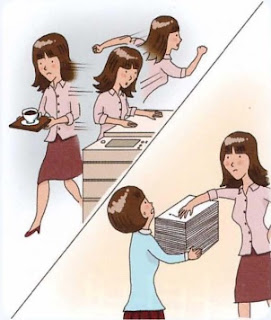
가: 회사를 그만둘까 생각 중이에요. 직장 상사들이 저보고 커피 타 와라,서류 복사해 와라 하면서 이것저것 시키는 게 너무 많거든요.
가: I’m considering chitting my company. My superiors make me do all sorts of things, such as make coffee and make copies.
나: 신입 사원들한테는 원래 시키는 게 많아요. 소희 씨도 아랫사람이 들어오면 똑같이 그렇게 할걸요.
나: New employees are always made to do a lot of things. I think you’ll do exactly the same, Sohee when new employees come in under you.
가: 저는 달라요. 나이가 많다거나 선배라고 해서 아랫 사람을부려 먹지 않을 거 예요.
가: I’m different. Just because I might be older or considered a superior, I won’t make those under me do everything.
나: 에이, 지난번에 보니까 소희 씨도 윤정 씨보고 발표자료 준비하라고 시키던데요. 윤정 씨가 나이가 어리 니까 그랬던 거 아니 에요?
나: Hey, I recall you recently ordering Yunjeong to prepare some presentation materials. She’s younger than you, so isn’t that exactly what you were doing?
보고 is used to indicate the person to whom a question, request, suggestion or order is verbally directed. It is mainly used in colloquial speech when emoting the speech of others.
희선 씨가 세훈 씨보고 보고서 쓰는 걸 도와 달라고 하던데요.
Heesun asked Sehun to help write the report.
의사 선생님이 아버지보고 담배를 끊으라고 하시더라고요.
The doctor told my father to stop smoking.
남편이 저보고 보라색이 잘 어울린다고 했어요.
My husband told me that I look good in purple.
1. This expression can be replaced with 더러 with no major change in meaning.
• 희선 씨가 세훈 씨더러 보고서 쓰는 걸 도와 달라고 하던데요.
• 의사 선생님이 아버지더러 담배를 끊으라고 하시더라고요.
In addition, when 더러 is used after the pronoun 나 or 너, they are often combined with ㄹ더러 instead of simply 더러.
• 세호가 날더러 동아리 활동을 같이 하자고 하네 .
• 누가 널더러 이 일을 하라고 했어?
2. The particles 보고 and 더러 can be replaced with both 한테 and 에게.
• 김 선생님이 저보고 말을 놓으라고 하셨어요.
= 김 선생님이 저한테 말을 놓으라고 하셨어요.
However, when the sentence does not express quoted speech, then 한테 and 에게 cannot be replaced with 보고 or 더러.
• 요즘 수현 씨보고 무슨 일 있나요? (X)
ᅳ> 요즘 수현 씨한테 무슨 일 있나요? (〇)
Using 보고 here is incorrect because the sentence does not express emoted speech.
>> You can click on the title of each grammar below to see other grammar which also expresses ‘Citations and Quotations’
2. -(느)ㄴ다니까
3. -(느)ㄴ다면서
4. 에 의하면
>> Full of ‘Korean grammar in use – Intermediate’: Click here
>> Full of ‘Korean grammar in use – Advanced’: Click here
>> Follow my page to get Korean lessons: Say Hi Korean
